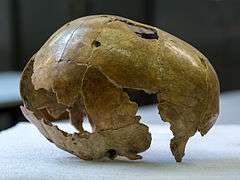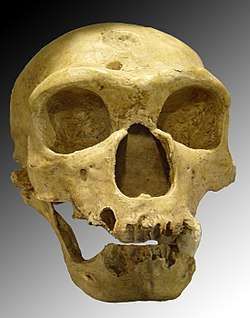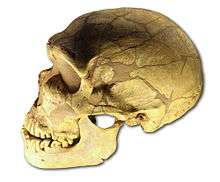List of Neanderthal fossils
This is a list of Neanderthal fossils.
Some important European Neanderthals
Remains of more than 300 European Neanderthals have been found. This is a list of the most notable.
| Name | Age | Cranial capacity (cm3) | Year discovered |
Country | Discovered by | Now located at | ||
|---|---|---|---|---|---|---|---|---|
| Ehringsdorf skull | 150k–120k | 1450 [1] | 1908–1925 | Germany | ||||
 |
Engis 2 | Undated | ? (child) | 1829 | Belgium | Philippe-Charles Schmerling | University of Liège | |
 |
Gibraltar 1 | 40k | 1200 [1] | 1848 | Gibraltar | Edmund Flint | Natural History Museum | |
| Gibraltar 2 | Undated | ? (child) | 1926 | Gibraltar | Dorothy Garrod | Natural History Museum | ||
| Krijn | 100-40 ka | (Not a full skull) | 2001 | Netherlands | Luc Anthonis | Rijksmuseum van Oudheden | ||
 |
La Chapelle-aux-Saints 1 | 60k | 1600[1] | 1908 | France | L. Bardon, A. Bouyssonie and J. Bouyssonie | ||
 |
La Ferrassie 1 | 70k–50k | 1641 [1] | 1909 | France | Louis Capitan and Denis Peyrony | Musée de l'Homme | |
 |
Neanderthal 1 | 40k | 1452 [1] | 1856 | Germany | Kleine Feldhofer Grotte | Rheinisches Landesmuseum Bonn | |
.jpg) |
Saccopastore 1 | 250k | 1200 [2] | 1929 | Italy | |||
| Saccopastore 2 | 250k | 1300 [3] | 1935 | Italy | Alberto Blanc and Henri Breuil | |||
| Altamura Man | 170k | 1993 | Italy |
Southwest Asian Neanderthals
As of 2017, this list of Southwest Asian Neanderthals may be considered essentially complete.
| Present-day country (country of discovery) | Site | Principal Neanderthal finds | MNI | Geological age (ka) | Descriptions | Notes |
|---|---|---|---|---|---|---|
| Turkey | Karain | Four teeth | 1 | — | Senyürek (1949)[4][5] | |
| Lebanon | Ksâr 'Akil | K2: Teeth and partial maxilla | 1 | — | Ewing (1963)[7] | Ewing lost this specimen while transferring Ksar Akil material from Boston College to Fordham University.[8] |
| Lebanon | El Masloukh | Upper second molar[9] | (1) | — | ? | Neanderthal attribution is stratigraphic, not morphological.[10] |
| Israel | Kebara | KMH1: 7-9 mo. old partial skel.
KMH2: Post-cranial adult ♂ Various fragments KMH3: Milk tooth (m1-r)[11] |
21 + (10) | 64-59[14][15] | KMH1: Smith et al. (1977)[16]
KMH2: Arensburg et al. (1985)[17] |
Neanderthal attribution uncertain in KMH18-23, 25, 29, and 31[11][13] |
| West Bank (Mandatory Palestine) | Shuqba | S-D1: Tooth and cranial frags.[9] | 1 | — | Keith (1931)[18] | |
| Israel (Mandatory Palestine) | Tabun | T C1: Nearly complete adult ♀ T C2: Toothed mandible missing I1 (♂) Various fragments T E1: Right femur shaft (♂?) |
15 | ≈170-90 | McCown (1936) McCown and Keith (1939) |
T C1: Neanderthal attribution is not universally accepted.[22]
As of 1975, the whereabouts of T BC2, B3, and BC6 are unknown.[9]:146 |
| Israel | Ein Qashish | (EQH-2: Third molar)
EQH-3: Adult lower limbs |
1 + (1)[23] | 70-60[23] | Been et al. (2017)[23] | Discovered in 2013, these were the first diagnostically Neanderthal remains in Southwest Asia not found in a cave.[23]
EQH-2: 70% posterior probability that Neanderthal attribution is correct.[23] |
| Israel | Shovakh | (Tooth, M(3)-l[24][Note 1]) | (1) | — | S. Binford (1966)[25] |
"[A]lthough within archaic and modern human ranges of variation, this complex occlusal morphology may suggest that it is more likely to have derived from a Neandertal than an early modern human". (Trinkaus 1987)[24] |
| Israel | Amud | A1: Adult full skeleton ♂
A2: Maxillary fragment A7: 10-mo.-old partial skel. |
3[Note 2][26] | 61-53[26] | A1: Suzuki et al. (1970)[27]
A7: Rak et al. (1994)[28] |
|
| Syria | Dederiyeh | D1: 19-30-month-old full skel.
D2: 21-30-month-old full skel. |
17 | — | D1: Akazawa et al. (1993)[29]
D2: Akazawa et al. (1999) [30] |
|
| Iraq | Shanidar | S1: Adult partial skel. ♂ S2: Adult crushed skel. ♂ |
10 | S2, S4: > 100
Others: 60 |
S1: Stewart (1959)[31] S2: Stewart (1961)[32] |
Shanidar 2 and 4 are sometimes not treated as Neanderthals.
All but Shanidar 3 and 10 (and fragments of 5 excavated in 2015-2016)[36] may have been destroyed in the 2003 invasion of Iraq.[40] |
| Iran | Wezmeh | maxillary right premolar tooth | 1 | 70-40[41] | Zanolli et al (2019)[41] | |
| Iran | Bisitun | Adult radius shaft | 1 | — | Trinkaus and Biglari (2006)[42] | |
| Total | 71 + (13) |
- M?-r according to S. Binford (1966)[25].
- Valladas, Mercier, and Froget (1999) write that "[o]f the remains of 18 individuals recovered at the Amud Cave, 15 were derived from unambiguous Middle Palaeolithic contexts, all of them located in the northern area of the excavation (Hovers et al., 1995). The stratigraphic distribution of these remains encompasses the layers B1 and B2, with only a single specimen derived from layer B4 (Sakura, 1970). Three individuals bear diagnostic characteristics which define them as Neanderthals. Amud I, the skeleton of an adult male was found at the top of layer B1, while the partial skeleton of the baby Amud 7 (Rak, Kimbet & Hovers, 1994) was recovered from the top of layer B2, just under the contact with the base of layer B1. Amud II, represented by a fragment of the right maxilla, was excavated from layer B2."
Central and North Asian Neanderthals
Central Asian Neanderthals were found in Uzbekistan and North Asian Neanderthals in Asian Russia.
| Country | Site | Principal Neanderthal finds | MNI | Geological age (ka) | Initial descriptions | Notes |
|---|---|---|---|---|---|---|
| Uzbekistan | Teshik-Tash | 8-11-yr-old skeleton | 1 | — | Okladnikov (1949) | |
| Uzbekistan | Obi-Rakhmat | Subadult skull frag. and teeth | 1 | 74[43] | Glantz et al. (2008)[44] | |
| Asian Russia | Chagyrskaya | Partial mandible | 1 | — | (Announced in Viola 2012) | |
| Asian Russia | Okladnikov | Sub-adult humerus and femur | 1 | (Announced in Krause et al. 2007)[45] | mtDNA sampled | |
| Asian Russia | Denisova | Altai 1: Toe phalanx♀ D11: Bone fragment | 2 | — | Mednikova (2011)
Brown, et al. (2016)[46] |
Altai 1: Full genome sequenced[47]
D11: mtDNA sampled |
| Total | 6 |
See also
- List of Southwest Asian Neanderthals
- Neanderthal Museum
- List of fossil sites
- List of human fossils
Notes
References
- Beals, K.L.; Dodd, S.M. (1984). "Brain size, cranial morphology, climate, and time machines". Current Anthropology. 25: 301–330. doi:10.1086/203138.
- Sergi, S. (1948). "The palaeanthropi in Italy: the fossil men of Saccopastore and Circeo". Man. 48: 61–79. doi:10.2307/2793251.
- Holloway, R.L. "The poor brain of Homo sapiens neanderthalensis: see what you please". In Delson, Eric (ed.). Ancestors: the Hard Evidence. pp. 319–324.
- M. Şenyürek (1949). "Türk Tarih Kurumu Adına Yapılan Karain Kazısında Bulunan İki Fosil Dişe Dair Kısa Ön Rapor". Belleten (in Turkish). 52: 833–837. Cited in Aytek and Harvati (2016)
- A.I. Aytek; K. Harvati (2016). "The Human Fossil Record from Turkey". In K. Harvati (ed.). Paleoanthropology of the Balkans and Anatolia: Human Evolution and its Context. Springer Netherlands.
- I. Yalçınkaya (1988). "9. Kazı Sonuçları Toplantısı". 1986 Yılı Karain Kazıları (in Turkish). pp. 15–37. Cited in Aytek and Harvati (2016)
- J.F. Ewing. "A probable Neanderthaloid from Ksâr 'Akil, Lebanon". American Journal of Physical Anthropology. 21. pp. 101–104.
- J.K. Williams; C.A. Bergman (2010). "Upper Paleolithic Levels XIII-VI (A and B) from the 1937-1938 and 1947-1948 Boston College Excavations and the Levantine Aurignacian at Ksar Akil, Lebanon". Paléorient. 36 (2): 117–161.
- K.P. Oakley; B.G. Campbell; T.I. Molleson (1975). Catalogue of fossil hominids: Part III. Americas, Asia, Australasia. London: British Museum (Natural History).
- S. El Zaatari. "The central Levantine corridor: The Paleolithic of Lebanon". Quaternary International. in press. pp. 1–15. doi:10.1016/j.quaint.2017.06.047.
- A.-M. Tillier; B. Vandermeersch; B. Arensburg; M. Chech (2003). "New human remains from Kebara Cave (Mount Carmel). The place of the Kebara hominids in the Levantine Mousterian fossil record". Paléorient. 29 (2): 35–62.
- i1-r, i1-l, m1-r, i2-r, lower c-r and c-l, m1-r, m1-l, m2-r, M1
- A. Le Cabec; P. Gunz; K. Kupczik; J. Braga; J.-J. Hublin (2013). "Anterior tooth root morphology and size in Neanderthals: Taxonomic and functional implications". Journal of Human Evolution. 64: 169–193. doi:10.1016/j.jhevol.2012.08.011.
- H. Valladas; J.L. Joron; G. Valladas; B. Arensburg; O. Bar-Yosef; et al. (1987). "Thermoluminescence dates for the Neanderthal burial site at Kebara in Israel". Nature. 330: 159–160. doi:10.1038/330159a0.
- H.P. Schwarcz; W.M. Buhay; R. Grün; H. Valladas; E. Tchernov; O. Bar-Yosef; B. Vandermeersch (1989). "ESR dating of the Neanderthal site, Kebara Cave, Israel". Journal of Archaeological Science. 16 (6): 653–659. doi:10.1016/0305-4403(89)90029-0.
- P. Smith; B. Arensburg (1977). "A Mousterian skeleton from Kebara Cave". In B. Arensburg; O. Bar-yosef (eds.). Moshe Stekelis Memorial Volume. Jerusalem: The Israel Exploration Society. pp. 164–176.
- B. Arensburg; O. Bar-Yosef; M. Chech; P. Goldberg; H. Laville; L. Meignen; Y. Rak; E. Tchernov; A.-M. Tillier; B. Vandermeersch (1985). "Une sépulture néandertalienne dans la grotte de Kébara (Israël)". Comptes Rendus de l'Académie des Sciences (in French) (300): 227–230.
- A. Keith (1931). New Discoveries Relating to the Antiquity of Man. London: William and Norgate. pp. 204–208. Retrieved 15 February 2017.
- A. Jelinek. "The Middle Paleolithic in Southern Levant, with comments on the appearance of modern Homo sapiens". In A. Ronen (ed.). The transition from Lower to Middle Paleolithic and the origin of modern man.
- R. Grün; C.B. Stringer (2000). "Tabun revisited: Revised ER chronology and new ESR and U-series analyses of dental material from Tabun C1". Journal of Human Evolution. 39 (6): 601–612. doi:10.1006/jhev.2000.0443. PMID 11102271.
- B. Vandermeersch. "Neanderthal Geographical and Chronological Variation". In S. Condemi; G.-C. Weniger (eds.). Continuity and Discontinuity in the Peopling of Europe: One Hundred and Fifty Years of Neanderthal Study.
- A.-M. Tillier (2005). "The Tabun C1 skeleton: A Levantine Neanderthal?". Mitekufat Haeven: Journal of the Israel Prehistoric Society. 35: 439–450.
- E. Been; E. Hovers; R. Ekshtain; A. Malinski-Buller; N. Agha; A. Barash; D.E. Bar-Yosef Mayer; S. Benazzi; J.-J. Hublin; L. Levin; et al. (2017). "The first Neanderthal remains from an open-air Middle Palaeolithic site in the Levant". Scientific Reports. 7 (2958). doi:10.1038/s41598-017-03025-z. PMC 5462778. PMID 28592838.

- E. Trinkaus (1987). "The Upper Pleistocene Human Molar from Me'arat Shovakh (Mugharet Esh-Shubbabiq), Israel". Paléorient. 13 (1). pp. 95–100.
- S. Binford (1966). "Me'arat Shovakh (Mugharet esh-Shabbabiq)". Israel Exploration Journal. 16 (2): 96–103.
- H. Valladas; N. Mercier; L. Froget (1999). "TL dates for the Neanderthal site of the Amud Cave, Israel". Journal of Archaeological Science. 26. pp. 259–268. doi:10.1006/jasc.1998.0334.
- Suzuki, Hisashi; Takai, F. (1970). The Amud man and his cave site. Tokyo: Keigaku Publishing Co.
- Y. Rak; W.H. Kimbel; E. Hovers (1994). "A Neandertal infant from Amud Cave, Israel". Journal of Human Evolution. 26 (4): 313–324. doi:10.1006/jhev.1994.1019.
- T. Akazawa; Y. Dodo; S. Muhesen; A. Abdul-Salam; Y. Abe (1993). "The Neanderthal Remains from Dederiyeh Cave, Syria: Interim Report". Anthropological Science. 101 (4): 361–387.
- T. Akazawa; S. Muhesen; H. Ishida; O. Kondo; C. Griggo (1999). "New Discovery of a Neanderthal Child Burial from the Dederiyeh Cave in Syria". Paléorient. 25 (2): 129–142.
- T.D. Stewart (1959). "Restoration and study of the Shanidar I Neanderthal skeleton in Baghdad, Iraq". Year Book of the American Philosophical Society for 1958: 274–278.
- T.D. Stewart (1961). "The Skull of Shanidar II". Sumer. 17: 97–106.
- R.S. Solecki (1960). "Three adult Neanderthal skeletons from Shanidar cave, northern Iraq". Annual Report of the Smithsonian Institution for 1959: 603–635.
- T.D. Stewart (1963). "Shanidar skeletons IV and VI". Sumer. 19: 8–26.
- E. Trinkaus (1977). "The Shanidar 5 Neanderthal skeleton". Sumer. 33: 35–41.
- E. Pomeroy; M.M. Lahr; F. Crivellaro; L. Farr; T. Reynolds; C.O. Hunt; G. Barker. "Newly discovered Neanderthal remains from Shanidar Cave, Iraqi Kurdistan, and their attribution to Shanidar 5". Journal of Human Evolution. 111. pp. 102–118. doi:10.1016/j.jhevol.2017.07.001.
- M.S. Şenyürek (1957). "The skeleton of the fossil infant found in Shanidar cave, northern Iraq". Anatolia. 2: 49–55.
- M.S. Şenyürek (1957). "A further note on the paleolithic Shanidar infant". Anatolia. 2: 111–121.
- L.W. Cowgill; E. Trinkaus; M.A. Zeder (2007). "Shanidar 10: A Middle Paleolithic immature distal lower limb from Shanidar Cave, Iraqi Kurdistan". Journal of Human Evolution. 53 (2): 213–223. doi:10.1016/j.jhevol.2007.04.003.
- B. Wood, ed. (2013). Wiley-Blackwell Encyclopedia of Human Evolution. Wiley-Blackwell. ISBN 978-1-118-65099-8.
- Zanolli Clément, Biglari Fereidoun, Mashkour Marjan, Abdi Kamyar, Monchot Herve, Debue Karyne, Mazurier Arnaud, Bayle Priscilla, Le Luyer Mona, Rougier Hélène, Trinkaus Erik, Macchiarelli Roberto (2019). "Neanderthal from the Central Western Zagros, Iran. Structural reassessment of the Wezmeh 1 maxillary premolar". Journal of Human Evolution. 135: 102643. doi:10.1016/j.jhevol.2019.102643.CS1 maint: multiple names: authors list (link)
- E. Trinkaus; F. Biglari (2006). "Middle Paleolithic Human Remains from Bisitun Cave, Iran". Paléorient. 32 (2): 105–111.
- Bailey, S. E. (2008). "The affinity of the dental remains from Obi-Rakhmat Grotto, Uzbekistan". Journal of Human Evolution. 55 (2): 238–248. doi:10.1016/j.jhevol.2008.03.004. PMID 18486185.
- Glantz, Michelle; Viola, Bence; Wrinn, Patrick; Chikisheva, Tatiana; Derevianko, Anatoly; Krivoshapkin, Andrei; Islamov, Uktur; Suleimanov, Rustam; Ritzman, Terrence (August 2008). "New hominin remains from Uzbekistan". Journal of Human Evolution. 55 (2): 223–237. doi:10.1016/j.jhevol.2007.12.007. PMID 18499228.
- Krause, Johannes; Orlando, Ludovic; Serre, David; Viola, Bence; Prüfer, Kay; Richards, Michael P.; Hublin, Jean-Jacques; Hänni, Catherine; Derevianko, Anatoly P.; Pääbo, Svante (30 September 2007). "Neanderthals in central Asia and Siberia". Nature. 449 (7164): 902–904. Bibcode:2007Natur.449..902K. doi:10.1038/nature06193. PMID 17914357.
- Brown, Samantha; Higham, Thomas; Slon, Viviane; Pääbo, Svante (March 29, 2016). "Identification of a new hominin bone from Denisova Cave, Siberia using collagen fingerprinting and mitochondrial DNA analysis". Scientific Reports. 6: 23559. Bibcode:2016NatSR...623559B. doi:10.1038/srep23559. PMC 4810434. PMID 27020421.
- Prüfer, Kay (2013). "The complete genome sequence of a Neanderthal from the Altai Mountains". Nature. 505 (1): 43–49. Bibcode:2014Natur.505...43P. doi:10.1038/nature12886. PMC 4031459. PMID 24352235.
Further reading
- Arsuaga, Juan Luis (2009). The Neanderthal's Necklace: In Search of the First Thinkers. New York: Four Walls Eight Windows. ISBN 0786740736.
- Gooch, Stan (2008). The Neanderthal Legacy: Reawakening Our Genetic and Cultural Origins. Rochester, Vermont: Inner Traditions. ISBN 159477742X.
- Muller, Stephanie Muller; Shrenk, Friedemann (2008). The Neanderthals. New York: Routledge. ISBN 1134095163.
- Silberman, Neil Asher, ed. (2012). The Oxford Companion to Archaeology (2 ed.). Oxford: Oxford University Press. ISBN 0199735786.
- Stringer, Chris (2012). Lone Survivors: How We Came to Be the Only Humans on Earth. New York: Macmillan. ISBN 1429973447.